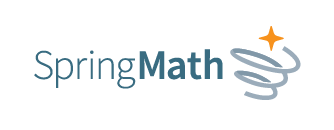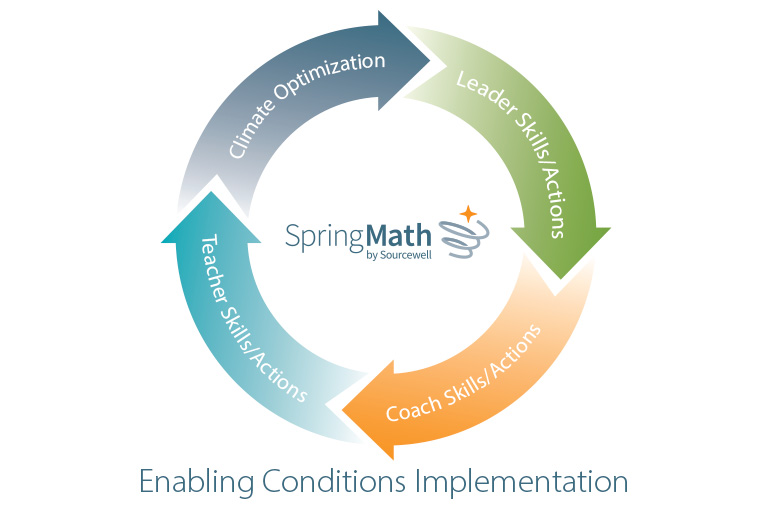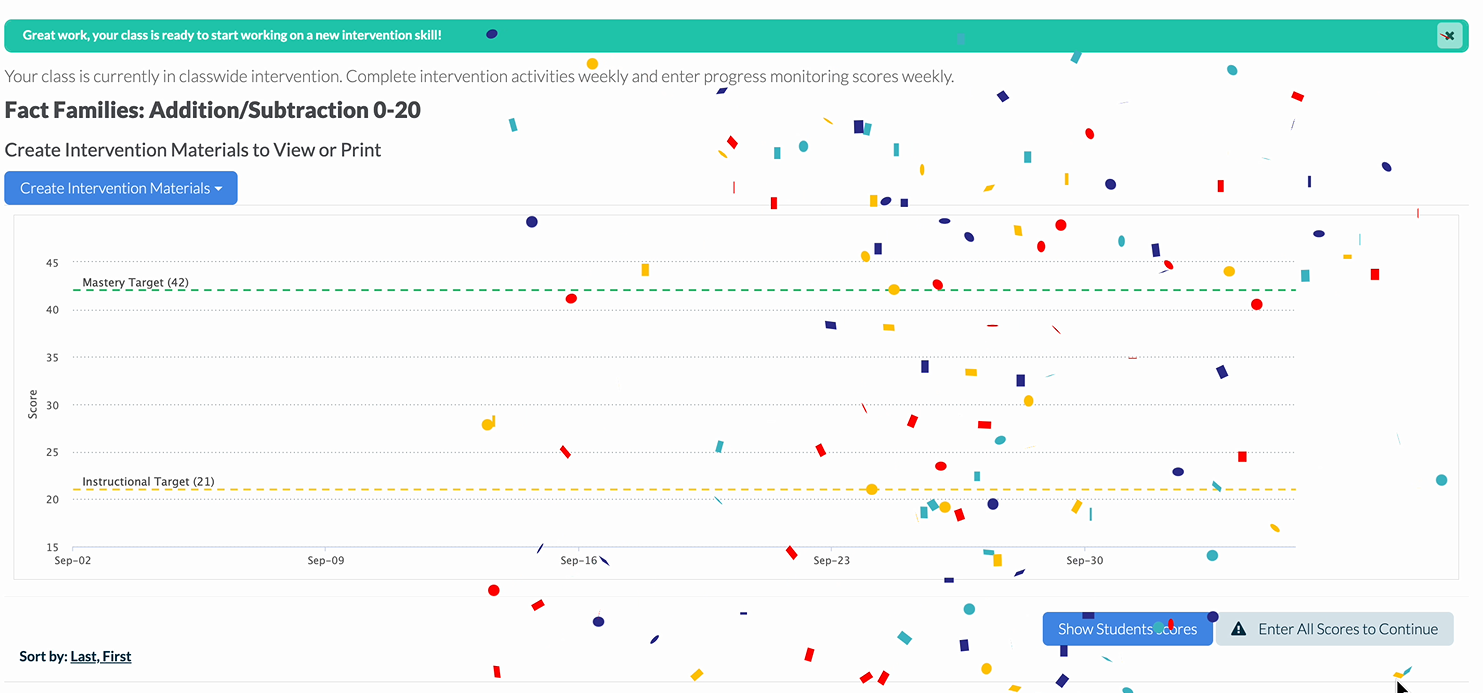Bring your SpringMath implementation to the next level
By SpringMath Author, Dr. Amanda VanDerHeyden
Strong MTSS implementation does not happen overnight. Excellent implementation is never done; rather, it’s an ongoing process of taking specific actions, watching the effects in real time and context, and reflecting on how to adjust actions to get stronger effects. Each new school year brings fresh energy and renewed opportunities to implement math instruction more effectively.
One thing I have reflected on this summer is the idea that many leaders focus on cultivating behaviors and beliefs prior to expecting behavioral change, believing perhaps that actions follow feelings; but it seems equally true that feelings follow behavior. My wish for 2024-2025 is that systems figure out how to do some of both, in tandem, with reflection on growth in between actions. As teachers experience the rewards of correct implementation of SpringMath, they will gain confidence and energy to continue implementing.
Similarly, superintendents should discuss school-level and district-level effects with school principals and other members of the district leadership team. Superintendents ultimately guide the mission, determine the communication strategy with the school board and community, and supervise the work of school principals. The most successful implementations are systems in which superintendents and principals are comfortable logging into their accounts to view school and district-level reports.
Superintendents, principals, coaches, and teachers must lead differently and effectively to correctly use SpringMath. Below we summarize the key implementation actions of system leaders and teachers.
Once you have your team assembled, work through the implementation rubric as a team. For each item, review the item and as a team, decide if “yes” or “no” applies for your school. If the answer is “no,” this item becomes a target to systematically work on as you begin implementation. Use the templated action plan to document your plan for the year for implementation. The rubric provides resources to help you improve on each implementation action with the goal being to attain a “yes” on that item during your implementation. Your action plan is a working plan that should be reviewed and adjusted during your leadership meetings based on the results of your ongoing implementation effort.
Program evaluation is an important undertaking that should occur at the leadership level at least once per year (you can access the full program evaluation at any time during the year — it will display the data that are available at that point of the year). We strongly recommend that your data administrator or coach upload external data like your year-end test data so that you can fully characterize how well SpringMath is working and where implementation needs improvement.
“In SpringMath, there is no downside to screening right away because screening will most likely be followed by classwide math intervention."
- Dr. Amanda VanDerHeyden, SpringMath author
Don't be afraid to begin
Some leaders feel they must understand everything that might unfold before they start, which can cause leaders to feel overwhelmed and experience “analysis by paralysis.” It is true that technical know-how is needed to take the right actions in the right order. For example, leaders need to understand that universal screening includes all students and should be done in a timely way at the beginning of the year since intervention cannot begin until screening has been conducted. Further, it is helpful to understand that, in SpringMath, there is no downside to screening right away because screening will most likely be followed by classwide math intervention which becomes the second screening gate. The “how-to” mechanics of screening, classwide intervention, diagnostic assessment and small-group or individual intervention are relatively easy to master but are best learned in incremental steps. Think of implementation as prepare-attempt review cycles that repeat throughout the year. The entire effort can be broken down into incremental steps: complete screening, begin classwide intervention where indicated, implement classwide intervention well, including delivering whole-class acquisition lessons using the materials provided when the system advises and adding the 3-minute booster add-on when the system advises.
Use adaptive leadership
Understand the technical ingredients but recognize that any successful implementation involves adaptive leadership. Technical leadership is knowing what to do when. For example, technical leadership involves knowing where to get the screening materials, how to administer the screenings, and where to enter the scores. Adaptive leadership, on the other hand, requires the same technical mastery but it involves finding solutions to problems that were not specifically explained in training manuals or may be unique to your context. You could think of adaptive leadership as being more dynamic, more responsive and recursive, and that has the effect of moving the implementation forward step by step. The onboarding session required for SpringMath will equip your teachers and leaders to access their SpringMath data, administer screening measures, and begin classwide intervention. There are many resources available inside SpringMath to assist you in launching classwide intervention. In fact, there is a whole section of support dedicated to classwide math intervention for teachers and coaches. However, adaptive leadership will be required to contend with the unique contextual barriers to implementation that may arise in your school (e.g., new principal or math coach, simultaneous introduction of a new curriculum, specific skills and biases that teachers bring to the effort).
Implementation of classwide math intervention is the primary goal of first-year SpringMath so it should be prioritized as the goal of team meetings in the first year. Organize your data teams to view and react to your SpringMath dashboards. Set small weekly goals with teachers. For example, one goal might be to use the booster activities when they are recommended inside the teacher dashboard. Another goal might be to implement the whole-class acquisition lessons effectively when they are recommended.
Use your coach dashboard to know where to go and how to help teachers with implementation. Teachers should view their growth at least weekly in their classwide intervention dash. They should also click on their Growth tab in their dashboards weekly and use the Individual Student Skill Progress button to view a report of which students are at frustrational, instructional, and mastery performance on each of the classwide intervention skills.
On the day of screening, the teacher reads the standard directions, works a sample problem with students as specified in the administration instructions, then starts and stops the assessment when the time is up. A video icon can be seen next to each screening skill name which teachers can view to see how to model problem completion (or teachers can simply show that video to the class before beginning).
Each screening measure will generate with an answer key that the teacher can use to quickly score each measure for the total number of correctly completed problems. Because the student roster is in alphabetical order, it is helpful for the teacher to alphabetize and then enter the scores all at once for his or her class.
Once all scores have been entered, SpringMath generates graphs and interprets results indicating whether or not a classwide intervention is needed and opens the classwide intervention dashboard for the teacher when classwide intervention is needed (and it usually is). Most teachers have a relatively easy time completing the screening and total time invested is usually about 20 minutes including scoring and data entry.
Screening is a great start to the process because most teachers have easy success with it. Leaders' jobs are easy here and involve verifying that screening is completed by all teachers in the timeframe selected (leaders can see this information right in their dashboards).
Success in the first two skills in classwide intervention is the marker of your success
Classwide intervention is the most important thing you do in your first year of implementation and in comparison with screening, classwide intervention is a more challenging MTSS action for teachers to take. Before beginning, equip your teachers for success, making sure they know how to access the materials they will need, set a starting date, and commit to being present and engaged in data team reviews at least weekly during the first four weeks.
Implementation is behavior and just like all behaviors, it is susceptible to the laws that govern human behavior. When establishing new behavior, it is critical to provide strong support for correct implementation up-front with a gradual release of support over time as the proficiency increases. In the first two weeks of classwide intervention, a trainer in your system should observe and assist in classrooms during classwide math intervention, using the checklist and resources in the SpringMath support portal, like "How to support a class that is not making progress" and "Tips and tricks for success". As when learning any new skill, it may be helpful to model correct use of classwide math intervention, assist the teacher side-by-side in the classroom to correctly complete each step in the intervention (there are several videos of classwide math intervention in Support). It can be especially helpful to actively troubleshoot with the teacher any barriers to correct implementation and to address and prevent implementation errors in real time.
Your first implementation milestone is success in the first two skills. Generally, classes that do not implement effectively, never advance beyond the first 1-3 skills in the classwide intervention sequence. The skill sequences always begin with below-grade-level skills that should be easily mastered by nearly all students given the full dosage of classwide math intervention.
Effective implementation means that all the steps of the intervention (six minutes of partner practice using the practice materials and talking aloud while they solve problems with partners switching roles at the three-minute mark, then independent practice, marking problems correct or incorrect with teacher guidance, correcting their errors, and a class reward for meeting a goal) are followed four to five days per week. The entire process should take about 20 minutes. Students should know the routine (how to get their materials, get into their working pairs, and what good partner practice looks like). If you step into the room as an observer, you should see that students anticipate each step of the intervention because they have been doing the intervention consistently. Students should be actively engaged and all children should be responding. Scores should increase daily and weekly.
Common implementation errors include skipping the intervention altogether, not doing all the steps of the intervention (e.g., not scoring the problems immediately after independent practice, not having students correct their errors after the scoring, or not giving a reward for improved performance), and entering incomplete or incorrect data into the teacher dashboard which prevents students from moving on to the next skill. All of these errors undermine the active ingredients of the intervention and totally compromise its efficacy.
During the first two weeks of intervention, teachers and students are developing and learning the daily routine. Efforts to correctly implement in the first two weeks set the foundation and yield benefits for the rest of the school year. There are generally about 20-24 skills in each grade-level skill sequence and there are only 36 weeks in most school years. So, it is important to begin right away, to expect success in the first skills which are below-grade-level skills, and to establish a strong routine of correct implementation. Classes that are successful in the first 2-4 skills of the classwide intervention have a much higher probability of mastering the more challenging skills that follow. They also master more skills overall.
If growth is occurring but is slow in the first 2-4 skills, work with your teams to fully implement classwide intervention, to fully use the activities that are recommended inside the teacher dashboard including whole-class acquisition lessons and three-minute booster activities for which no additional printing is required. You can also provide children with extra practice outside of the intervention sessions by accessing games, flashcards, or even extra practice sheets in Support.
Focus first on highly effective classwide intervention implementation in your first year of implementation
Follow the recommended actions in your dashboard with one exception. It is okay to delay individual intervention until you have classwide intervention working very well in a classroom. All children show benefit from classwide math intervention. Therefore, your work in classwide intervention is a high-leverage strategy (low cost, high benefit) for your students and will produce gains on year-end tests when children receive an adequate dose. In other words, classwide intervention is not just a waiting period to get to individual intervention. The higher your dosage of classwide intervention, the greater the benefit to your students.
Further, the higher your dosage of classwide intervention, the greater the accuracy of our recommendation for which students truly need individual intervention. Thus, there is no downside to focusing on classwide intervention and making sure you are doing it well before beginning individual intervention.
The beginning of the year is an exciting time to begin or begin again. The most predictable outcome of high-quality SpringMath use is gains on external measures like your year-end test. If you are not seeing those gains, then your implementation needs some troubleshooting. Sign up for our free virtual community meetings where we provide some training and conduct live Q & A. Access the resources in Support. Reach out to your school’s SpringMath coach. Our team is here to help.



